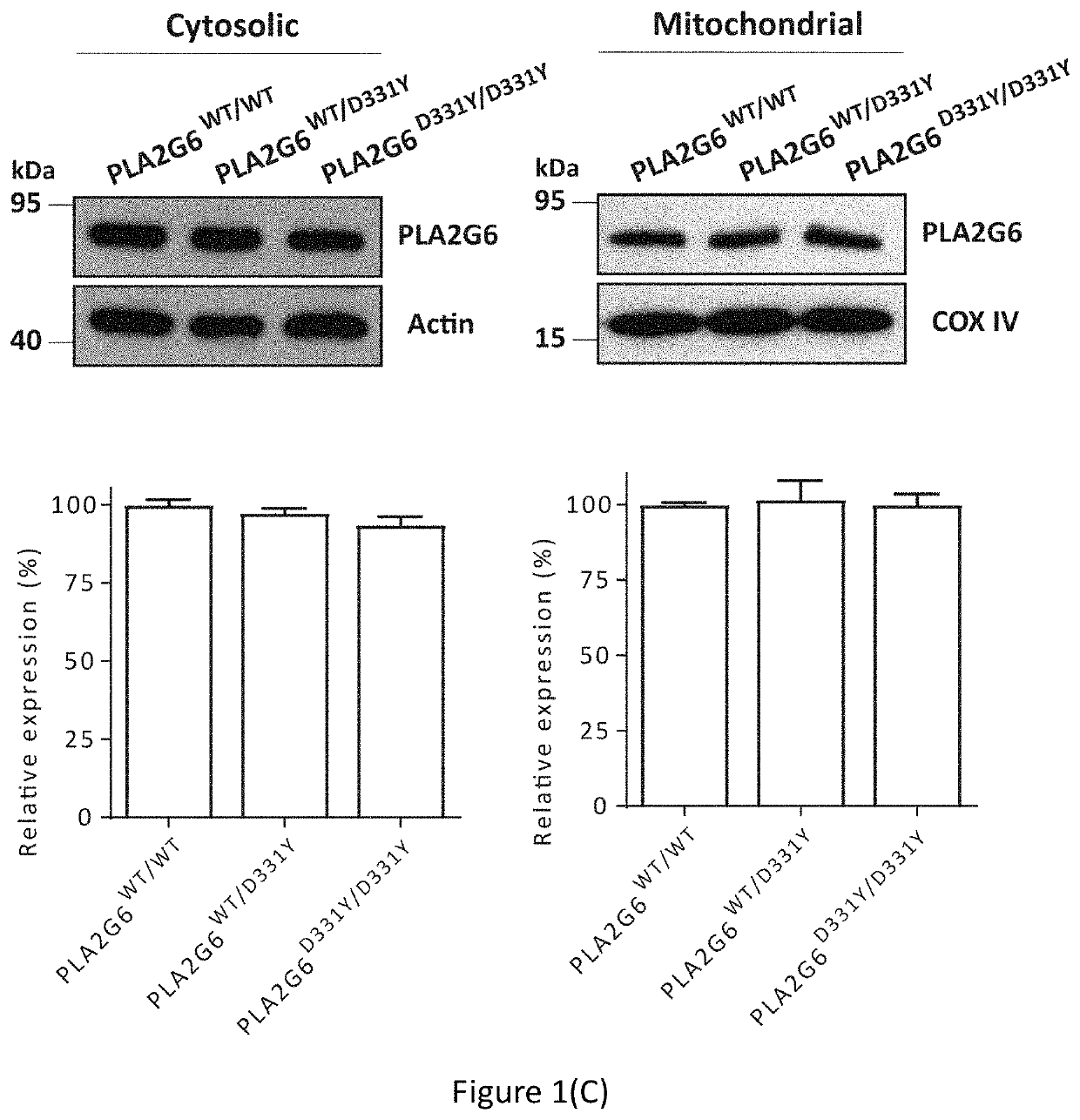Early-onset parkinson's disease model: (D331Y) pla2g6 knockin model, platform and method for drug screening, and kit of detection
- Summary
- Abstract
- Description
- Claims
- Application Information
AI Technical Summary
Benefits of technology
Problems solved by technology
Method used
Image
Examples
example 1
PLA2G6D331Y / D331Y Homozygous Knockin (KI) Mice Exhibit a Decreased PLA2G6 Activity in the Substantia Nigra (SN).
[0097]To generate knockin mice expressing PARK14 mutant (D331Y) PLA2G6, human (D331Y; GAC→TAC) mutation was introduced into the exon 7 of mouse PLA2G6 gene by knockin target vector-mediated homologous recombination. The resultant heterozygous PLA2G6WT / D331Y knockin mice were bred and intercrossed to generate wild-type mice, heterozygous PLA2G6WT / D331Y mice and homozygous PLA2G6D331Y / D331Y knockin mice (FIG. 1A). RT-PCR assay using total RNA purified from SN and Sanger sequencing were performed to confirm (D331Y) PLA2G6 mutation (FIG. 1B).
[0098]PLA2G6 is localized in the cytosol and mitochondria. Cytosolic protein expression of PLA2G6 in the SN of PLA2G6WT / D331Y or PLA2G6D331Y / D331Y mice was similar to that of PLA2G6 in the SN of WT mice (FIG. 1C). Mitochondrial protein expression of PLA2G6 in the SN of PLA2G6WT / D331Y or PLA2G6D331Y / D331Y mice was also not significantly alt...
example 2
PLA2G6D331Y / D331Y KI Mice Display Early-Onset Degeneration of SNpc Dopaminergic Neurons
[0099]Homozygous (D331Y) PLA2G6 mutation causes early-onset autosomal-recessive PD. Immunohistochemical tyrosine hydroxylase (TH) staining was performed using 3- to 9-month-old heterozygous or homozygous (D331Y) PLA2G6 mice. The number of TH+-SNpc dopaminergic cells of PLA2G6D331Y / D331Y knockin mice at the age of 3 months was not significantly different from that of age-matched PLA2G6WT / D331Y or WT mice (FIG. 2A and 2C). Compared with WT mice, 6- or 9-month-old homozygous PLA2G6D331Y / D331Y mice exhibited a significant reduction in the number of TH+-SNpc dopaminergic cells (FIGS. 2A and 2C). PLA2G6WT / D331Y did not display cell death of TH+-SNpc dopaminergic neurons (FIGS. 2A and 2C). Six- or nine-month-old PLA2G6D331Y / D331Y mice exhibited a significant reduction in the number of Niss1+-cells of SNpc (FIG. 2D and FIG. S1) Immunocytochemical staining of NeuN, a neuronal marker, demonstrated that neur...
example 3
PLA2G6D331Y / D331Y KI Mice Exhibit Lewy Body-Like Pathology
[0101]Lewy body, which is mainly composed of α-synuclein (αSyn), phosphorylated α-synuclein and other components, is the neuropathological hallmark of Parkinson's disease Immunohistochemical staining using anti-phospho-α-synucleinSer129 (p-αSyn) (FIG. 3A-3C) antiserum and anti-αSyn antibody (FIG. 3D-3F) demonstrated that Lewy bodies were found in the SN of PLA2G6D331Y / D331Y mice at the age of 9 months Immunoblotting analysis demonstrated that PLA2G6D331Y / D331Y KI mice at the age of 9 months displayed an upregulated protein expression of αSyn and p-αSyn (FIG. 3G) Immunofluorescence staining showed that the formation of αSyn aggregates was observed in the TH+-SN dopaminergic neuron of PLA2G6D331Y / D331Y mice. Lewy body-like inclusions can be biochemically analyzed in sarkosyl-insoluble fraction. To confirm α-synuclein pathology, the accumulation of αSyn and p-αSyn was examined in the sarosyl-insoluble fraction obtained from the ...
PUM
| Property | Measurement | Unit |
|---|---|---|
| Fraction | aaaaa | aaaaa |
| Time | aaaaa | aaaaa |
| Capacitance | aaaaa | aaaaa |
Abstract
Description
Claims
Application Information
 Login to View More
Login to View More - R&D
- Intellectual Property
- Life Sciences
- Materials
- Tech Scout
- Unparalleled Data Quality
- Higher Quality Content
- 60% Fewer Hallucinations
Browse by: Latest US Patents, China's latest patents, Technical Efficacy Thesaurus, Application Domain, Technology Topic, Popular Technical Reports.
© 2025 PatSnap. All rights reserved.Legal|Privacy policy|Modern Slavery Act Transparency Statement|Sitemap|About US| Contact US: help@patsnap.com



